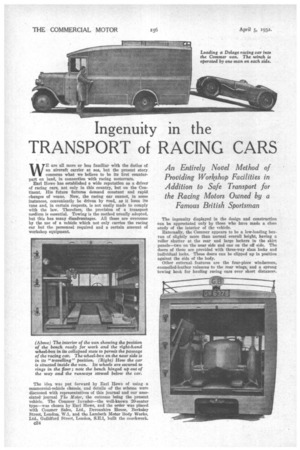Ingenuity in the TRANSPORT of RACING CARS
Page 46

Page 47

If you've noticed an error in this article please click here to report it so we can fix it.
An Entirely Novel Method of Providing Workshop Facilities in Addition to Safe Transport for the Racing Motors Owned by a Famous British Sportsman
WE are all more or less familiar with the duties of an aircraft carrier at sea, but the present story concerns what we believe to be its first counterpart on land, in connection with racing motorcars.
Earl Howe has established a wide reputation as a driver of racing cars, not only in this country, but on the Continent. His future fixtures demand constant and rapid changes of venue. Now, the racing car cannot, in some instances, conveniently be driven by road, as it loses its tune and, in certain respects, is not easily made to comply with the law. Therefore, the provision of a transport medium is essential. Towing is the method usually adopted, but this has many disadvantages. All these are overcome by the use of a vehicle which not only carries the racing ear but the personnel required and a certain amount of workshop equipment.
The idea was put forward by Earl Howe of using a commercial-vehicle chassis, and details of the scheme were discussed with representatives of this journal and our associated.' journal The Motor, the outcome being the present vehicle. The Commer Invader—the well-known 20-seater type—was chosen by Earl Howe, and the order was placed with Commer Sales, Ltd., Devonshire House, Berkeley Street, London, W.1, and the Lambeth Motor Body Works, Ltd., Guildford Street, London, S.E.1, built the coachwork.
4:24 The ingenuity displayed in the design and construction can be appreciated only by those who have made a close study of the interior of the vehicle.
Externally, the Commer appears to be a low-loading boxvan of slightly more than normal overall height, having a roller shutter at the rear and large lockers in the skirt panels—two on the near side and one on the off side. The doors of these are provided with three-way slam locks and individual locks. These doors can be clipped up in position against the side of the body.
Other externalfeatures are the four-piece windscreen, enamelled-leather valances to the rear wings, and a. sprung towing hook for hauling racing cars over short distances. The roof is equipped with rails so that a considerable amount of light baggage can be carried overhead ; access to this space is gained by folding steps at the rear. The dash is of the floating type.
In connection. with the roller shutter, this may be adjusted to any one of a. range of positions in order to allow, if necessary, the protrusion of the tail of a racing car. In addition to the external lock, this shutter can be bolted internally, and the complete vehicle is arranged so that its contents can completely be secured at any time.
Principal interest centres in the interior design. The main portion of the floor is devoted to the racing car to be transported. The Vehicle will carry any one of the present fleet of racers. When a car is in position, the wheel-boxes of the van are just in front of the rear wheels of the car. Along the off side are felt-lined racks for spare wheels and padded shelves for various items of equipment, such as drums to carry special fuels 'or lubricants. There are more of these racks of shelves on the near side, but behind the wheel-box is an ingenious metal-topped folding bench, with a vice.
When a car is carried the bench is folded up against the lining boards and secured by the same media which fix the Jogs to the floor. There are four roof lights, so that repairs can be carried out at any time. A clever feature is the provision of removable floorboards along the centre line of the Commer. These not only give access to the transmission, but enable mechanics to work on the underside of the racing car, as though they were in an inspection pit.
At the rear, inside the body, are two spotlights, one on each side, which have universal mountings permitting them to illuminate either the inside of the vehicle or to be used when work is proceeding outside. Every effort has been made to allow the vehicle to be a self-contained unit At the extreme rear two stout cross-bars passing through eye lugs form the anchorage for detachable and laterally adjustable runways, up which the car is pulled into the body. The effort required to raise the car is provided by a hand-operated winch mounted below the front seat. This seat is carried upon a metal sub-frame and is instantly detachable. When in place the car is secured to ring bolts in the floor.
Obviously, with a low loading line, wheel-boxes are essential. These have been made collapsible to allow the passage of the front wheels of the racer. First of all, the hinged top is raised and swung up parallel to the side of the body. The two ends of the box fold Outwards and downwards, forming gently sloping ramps. Next, the metal wheel-arch top is removed and the front of the wheel-box is folded inwards, thus forming a track for the car to pass over. When the racer is in place the wheel-boxes are restored to their original position.
Shear legs are provided for removal of cylinder heads, etc. These consist of two members carried upon the cross-bars at the rear, whilst the third member of the component consists of a cable from the winch.
Despite the fact that there is 43 ft. of headream inside the body, the vehicle does not present a top-heavy appearance. It is finished in blue and silver—the well-known racing colours of Earl Howe.












































































































